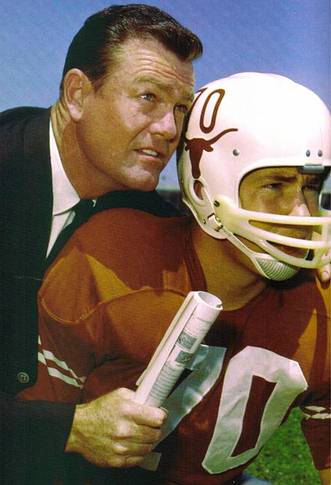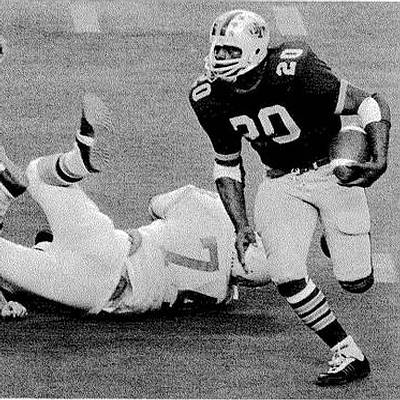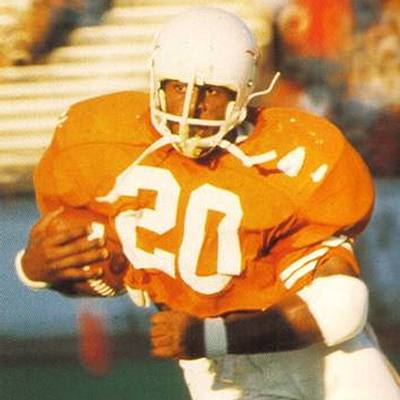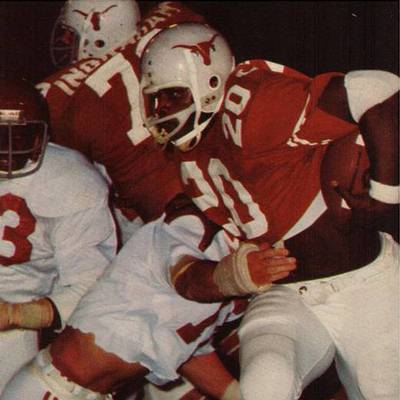

"Earl Campbell, Texas Longhorn Icon"
HELMET HUT NEWS/REFLECTIONS MAY 2009:
Earl Campbell, Texas Longhorn Icon
By Dr. Ken
When I discovered college football and found it to be the most exciting of spectacles, sporting or otherwise, I was “in” at one-hundred percent involvement. The teams that caught my attention, and this included many, had their rosters subjected to hours of study and memorization so that height, weight, and when the information could be found, high school attended were duly noted. For those universities that allowed little more than a passing interest, I could admit to knowing most of the starting lineups in any season between 1958 and 1964, when the time arrived for my own limited athletic career to move forward. During and after flings in try-out camps and a very brief stint in the Atlantic Coast Football League, coaching high school football and track while completing a Masters Degree and assuming family responsibilities allowed for limited leisure time but it was important from a professional perspective to be aware of the changes in the collegiate game if only to adapt what might be of value to our high school program. Taking the same approach to coaching as I did to playing and just “knowing” the game, I developed a correspondence with a number of well known collegiate coaches who were gracious enough to provide me with playbooks, game film, a lot of advice and information, and from some, tattered jerseys that we presented to our less fortunate youngsters as awards.
 |
One of those accommodating coaches was the great Darrell Royal of the University Of Texas who did all of the above and then took yet another step in helping a young coach who truly was in need of all of the help I could get.
Coach Royal enhanced my Wishbone Offense knowledge and abilities by providing a copy of the coaching staff’s game film with a complete written explanation of specific play choices, for every game of the 1969 season! I cannot begin to explain why he was so considerate to a bumbling unknown but he was and his advice and assistance made our Malverne High School Wishbone attack exceptionally productive.
|
|
QB James Street leads 1969 Longhorns Wishbone
As career changes moved me away from coaching high school football, I always maintained my focused interest upon college football and needless to add, Royal’s Texas teams were closely followed. It was easy to allow Texas to dominate my thoughts and provide inspiration as a high school player. I was aware that in the late 1950’s the Hall Of Fame level players were those like Bob Lilly of TCU and E. J. Holub of Texas Tech, not University Of Texas players. Halfback James Saxton who reputedly could run down rabbits and catch them with his bare hands brought the attention back onto Texas in 1961 as they resumed their dominant ways, most often battling Arkansas for the Southwest Conference title and linebacker and guard Tommy Nobis of course served as an inspiring role model as I completed my high school playing days, even though he was still an underclassman.
With the many great Texas teams and iconic uniform the Longhorns wore, with Royal’s monstrous reputation as a successful coach, many forget that the Texas Longhorns slumped, by Texas standards, after the graduation of “The Worster Crowd” in the early 1970’s. While much of the SWC would have traded for the Longhorns’ 8-4 mark of 1974, even with their 27-3 loss to Auburn in the Gator Bowl, and certainly for their 10-2 record the following season with a Bluebonnet Bowl win over Colorado, the level of previous success was not equated with a Bluebonnet Bowl appearance nor a four-loss season. The 1975 resurgence with what many thought would be a return to long term dominance in both the conference and on the national scene, came with the emergence of running back Earl Campbell out of Tyler, Texas. A nationally known recruit coming out of high school, Campbell had been a devastating linebacker, emulating his hero Dick Butkus. He was Sophomore Of The Year despite his team’s three-win season and as a junior, his head coach Corky Nelson, who would later be the head man at North Texas State University from 1982-1990 played him part-time at fullback.
 |
Earl Campbell of John Tyler HS 1973
As a senior, predictions weren’t grand for the John Tyler Lions but there was talent with Earl, his twin brothers Tim and Steve, tight end Ronnie Lee, and defensive lineman Gary Don Johnson. Lee and Johnson followed Nelson to Baylor when their head high school coach took an assistant’s job there and both played a number of seasons in the NFL. Still, it was Earl Campbell who powered the Lions to a perfect 10-0 season, and put up 1184 rushing yards and scored seventeen TD’s. Unbelievably, in five playoff games that culminated in the largest classification state championship and a perfect 15-0 record, Campbell rushed for 852 yards and another eleven touchdowns! At Texas, Earl’s first two seasons resulted in 2046 rushing yards, two All Conference awards, and All American recognition as a sophomore. In 1976 unfortunately, a nagging hamstring injury for this player who had never before suffered any injury, led to frustration, time on the bench, a lack of conditioning as his weight increased, and a lack of production resulting in only 653 yards that contributed to the Longhorns’ 5-5-1 record. Legendary coach Royal retired from his College Football Hall Of Fame career, new coach Fred Akers arrived with a Veer Offense, and Campbell finished his Texas reign successfully, completing his statistics with a total of 4443 rushing yards, the fifth highest all time collegiate total at that time.
 |
Campbell was devastating, running over would-be tacklers and just as often around them as he showed surprising speed for a 5’11”, 220 pounder. Despite his Pro Football Hall Of Fame career with the Oilers and Saints, Earl Campbell is most closely associated with his College Football Hall Of Fame performance at Texas. So close was his association with the ‘Horns’ program that fans throughout the nation have always seen him as a “Texas player” before that as one of his era’s most famous professional players. This association became the springboard for a lengthy career working for the University as an administrator and fund raiser. Earl Campbell’s association with his immediately recognizable number 20 and distinctive helmet are just as closely cherished by Texas fans. No college football fan can look at the Longhorn number 20 helmet with the Adams N-1000 white double bar mask with the N-800 vertical bar and not think “Wow, Earl Campbell and the great Texas teams.”
 |